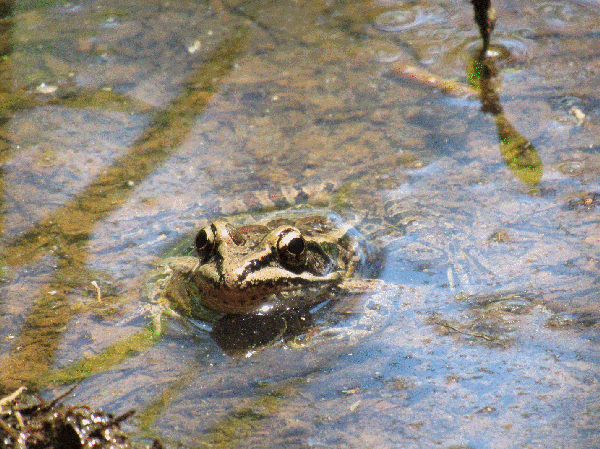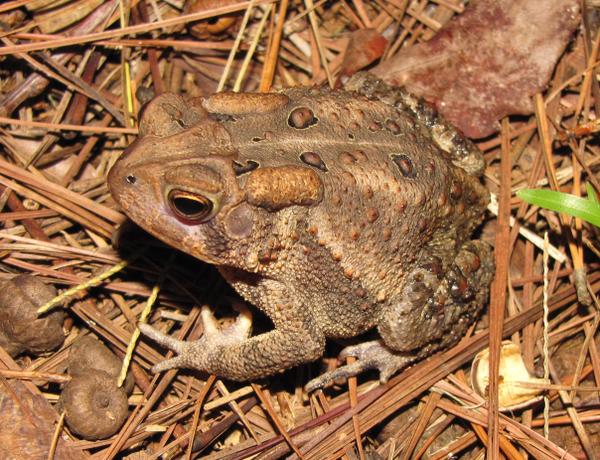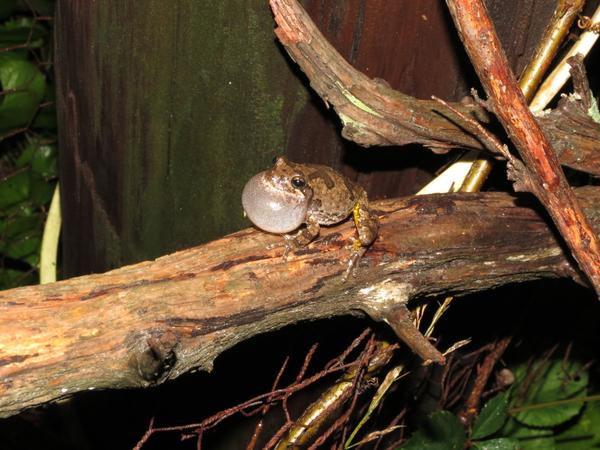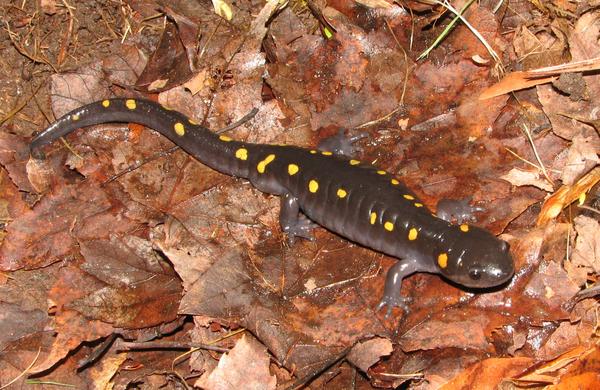North Carolina supports the greatest diversity of amphibians in the United States, over 90 species. Amphibians include frogs, toads, salamanders, and newts. They are a unique and diverse group of animals that breathe (or respire) though lungs, gills, or even their skin. The majority of North Carolina’s amphibians live a part of their lives in water and depend on moist environments for breeding, egg laying, and survival. However, due to habitat loss and degradation, along with increased air and water pollution, many amphibians are in conservation need.
Amphibians can be encouraged on your property by constructing and maintaining fishless pools. Fish are predators of amphibian adults, larvae (i.e. young), and eggs. Fish and other predators also compete with amphibians for food. By creating simple fishless pools on your own property, you can help amphibians survive, reproduce and multiply.
Food and Water
Amphibians are an important link in the food chain and depend on a variety of foods. As young, they may eat small insects, worms, and algae. Adult amphibians are carnivores and, depending on the species, may eat crayfish, fish, earthworms, snails, insects and their larvae, and even other amphibians.
| Spotted salamander | Southern cricket frog |
| Fowler's toad | Pickerel frog |
| Bullfrog | Marbled salamander |
| Southern chorus frog | Cope's gray tree frog |
| Southern leopard frog | Spring peeper |
Cover
Amphibians require water or moisture for survival. During all phases of their life cycle, amphibians live in moist or aquatic areas. Vegetation cover offers protection from the sun and wind, and offers areas for foraging, solitude, and protection. Cover around aquatic breeding areas offers protection from predators. Terrestrial amphibians depend on downed logs, rocks, loose soil, and leaf litter as protective cover.
Space
Generally, home range size varies with the size of the amphibian, with larger amphibians using larger areas. Some species spend their entire lives in one small area, while others may travel and disperse over a larger range.
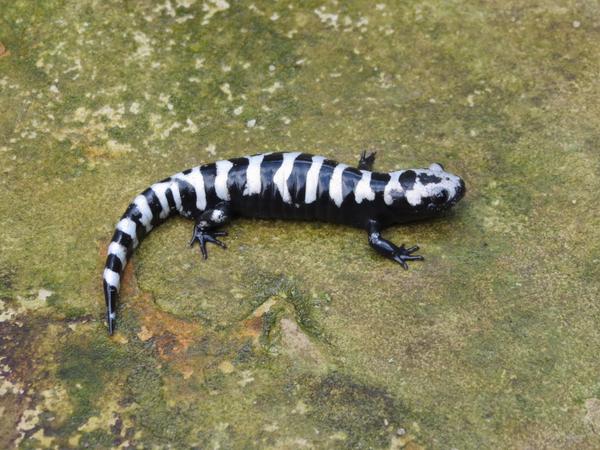
Marbled salamander, Ambystoma opacum. The marbled salamander is the official state salamander of North Carolina.
Alvin Braswell CC BY-NC 4.0
Protect What's There
Protect and enhance existing pools prior to building new ones. Identify and protect the key components of habitat listed below.
| Breeding (January - July) | Postbreeding (August - December) |
| Streamside areas | Downed logs |
| Floodplain pools | Moist or shaded rock |
| Beaver ponds | Wet seeps |
| Failed farm ponds | Headwaters of streams |
| Woodland road-ruts | Natural pools in mature pine / hardwood stands |
| Stump holes | |
| Upland depressions | |
| Holes from the roots of fallen trees |
After key areas are protected, additional pools can be built with only a little money, time, and work. Pool costs can vary from less than $50 for the smallest plastic-lined backyard pools to hundreds, even thousands of dollars for woodland pools of up to 1⁄4 acre. Inexpensive fishless pools can also be constructed with only a shovel by filling in old drainage ditches to allow water to stand.
Pools are easiest to fill and maintain on sites with a high water table and a clay soil-type. In sandy or loamy soils, locate pool sites in close proximity to wetland areas. Always consult with local authorities before disturbing existing or potential wetlands.
Choosing a Site
-
Ideal pool size ranges from 20 feet x 30 feet to 1⁄4 acre in size.
-
Optimal pool depth is between 11⁄2 and 21⁄2 feet. Because sunlight can reach the bottom of shallow pools, they are more productive with a greater availability of food, cover, and egg-laying sites. You can use shovels, bulldozer, tractor or backhoe to excavate a shallow depression. Never work alone when using heavy equipment!
-
Pools are easiest to fill and maintain on sites with a high water table and a clay soil-type. In sandy or loamy soils, locate pool sites in close proximity to wetland areas. Always consult with local authorities before disturbing existing or potential wetlands, and check with utility companies before digging.
-
Surprisingly, smaller pools often can support more breeding species than larger pools. While larger pools do not dry up as frequently, they may attract green frogs and bullfrogs - the primary predators of many other amphibians.
-
Be careful not to choose sites prone to flooding. Flooding can flush the pool or allow fish invasion.
-
Pools must be located adjacent to the protective cover that amphibians require after breeding.
-
Establish diverse plant communities in areas surrounding pools.
-
"Prime" new pools by adding vegetation, substrate, and even amphibian egg masses from nearby sites. This will speed up the maturity of the pool and enable amphibians to establish breeding sites sooner.
-
Selective thinning of woodlots promotes the open spaces and understory vegetation preferred by amphibians.
-
Complete new pools before winter because the majority of amphibians breed from late January to July. Pool construction is easiest during dry, summer months.
Maintenance of Pools
Pools are easy to manage. Follow these steps to improve and protect fishless pools:
- Install spillways to maintain the proper pool depth in areas prone to flooding.
- Keep pool clean by fencing riparian and wet areas to exclude livestock.
- Minimize disturbance in pool areas.
- Place shelters such as rotten logs, slabs, and brush piles on north-facing slopes of pools. Amphibians will also readily use old boards and rock piles adjacent to pools.
- Manage the immediate area for downed logs and the other constantly moist areas needed by amphibians.
- Avoid use of chemicals such as weed killers and insecticides. Amphibians are very sensitive to these chemicals and can be killed or injured from exposure,especially when pesticide label instructions are not followed.
References
Amphibians & Reptiles of the Carolinas and Virginia. University of North Carolina Press, Chapel Hill. 2010.
Beane, J.C., A.L. Braswell, J.C. Mitchell, W.M. Palmer, and J.R. Harrison III. Bailey, M.A., J.N. Holmes, K.A. Buhlmann, and J.C. Mitchell. Habitat Management Guidelines for Amphibians and Reptiles of the Southeastern United States. Partners in Amphibian and Reptile Conservation Technical Publication HMG-2, Montgomery, Alabama. (88 pp.) 2006.
“A Guide to Amphibian and Reptile Conservation.” T.R. Johnson. Missouri Department of Conservation publication 1979.
Biology of Amphibians. W.E. Duellman and L. Trueb. McGraw-Hill Book Co. New York. 1986.
Working With Wildlife
North Carolina State University Extension - Forestry
Working With Wildlife Series
Publication date: July 1, 2019
Reviewed/Revised: May 28, 2024
N.C. Cooperative Extension prohibits discrimination and harassment regardless of age, color, disability, family and marital status, gender identity, national origin, political beliefs, race, religion, sex (including pregnancy), sexual orientation and veteran status.
N.C. Cooperative Extension prohibits discrimination and harassment regardless of age, color, disability, family and marital status, gender identity, national origin, political beliefs, race, religion, sex (including pregnancy), sexual orientation and veteran status.

